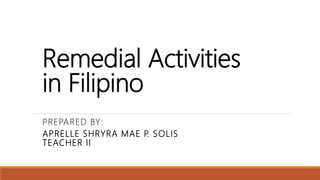
Inset 2020...
- 1. Remedial Activities in Filipino PREPARED BY: APRELLE SHRYRA MAE P. SOLIS TEACHER II
- 2. Objectives The participants are expected to: Identify the process in conducting Marungko Approach for beginning readers Differentiate Cartilla Method from Marungko Approach Make remedial activities in Filipino based on Marungko Approach
- 3. Cartilla Method Traditional phonics instruction used in Philippine schools Uses the new Filipino alphabet which is composed of 28 letters 20 letters are from the traditional Filipino alphabet called abakada (a, b, k, d, e, g, h, i, l, m, n, ng, o, p, r, s, t, u, w, y) 8 letters are from the Spanish alphabet (c, f, j, ñ, q, v, x, z) Has its roots in the country’s colonial past with Spain
- 4. Cartilla Method The letter-sound correspondence has been syllabic ba be bi bo bu ka ke ki ko ku Children are taught a set of syllables based on the sequence of the alphabet that vary by one vowel They are then taught to combine these syllables into words or break up these syllable chunks
- 5. Cartilla Method When decoding a word, most consonants were sounded out with an /a/ sound Letter b as “ba” Letter d as “da” Children would count off with their fingers and chant the syllables as they read a word anim – a-na-i-ma ikaw- i-ka-a-wa
- 10. Marungko Approach Example: Alphabets are rather pronounced than read m “mmm” “ma” s l “sss” “lll” “sa” “la” Letter-sound correspondence is taught
- 11. Marungko Approach It uses 28 letters of the new Filipino Alphabet. There is a specified sequence of letter and letter sounds to be taught to the children. The Marungko sequence is arranged according to the most frequent to the least occurring letters in the Filipino language.
- 12. Sequence of letters taught using MA m wd zj ñ q v x h c f n g png r ue y lkt oias b
- 13. Marungko Approach Letters are combined to form words Letters of the alphabet are introduced Words are then combined to form phrases and sentences Later, short stories are formed
- 14. Steps in Teaching Reading using MA 1. Pagpapakilala ng mga larawan ng mga bagay na nagsisimula sa tunog na pinag-aaralan 2. Pagbibigay ng pangalan ng titik at tunog nito 3. Pagpapasulat ng titik sa hangin, sa mesa, sa palad, atbp. 4.Pagbibigay ng pagsasanay
- 15. 1. Pagpapakilala ng mga larawan ng mga bagay na nagsisimula sa tunog na pinag-aaralan Aralin 1: Mm
- 16. 2. Pagbibigay ng pangalan ng titik at tunog nito Mm “mmm”
- 17. 3. Pagpapasulat ng titik sa hangin, sa mesa, sa palad, atbp. Mm
- 18. 4. Pagbibigay ng pagsasanay
- 19. 1. Pagpapakilala ng mga larawan ng mga bagay na nagsisimula sa tunog na pinag-aaralan 2. Pagbibigay ng pangalan ng titik at tunog nito 3. Pagpapasulat ng titik sa hangin, sa mesa, sa palad, atbp. 4. Pagbibigay ng pagsasanay Aralin 2: Ss Aralin 3: Aa
- 20. 5. Pagsasama-sama ng mga tunog upang makalikha ng isang makabuluhang salita m, s, a • Pagbasa ng pantig m + a a+s = = sa mamma + m mas=ma + s ma=
- 21. m, s, a ama mama asa sama sasama aasa masama • Pagbasa ng Salita
- 22. ama mama
- 23. Pagsasanay • Tingnan ang mga larawan. Pagdugtungin ang larawan at ang pangalan nito.
- 25. 6. Pagturo ng salitandaan o pantulong na mga salita Mga Paraan a. Ituro ang pagbasa b. Ituro ang spelling c. Isulat sa papel d. Isulat sa hangin na nakapikit e. Pagbigay ng pagsasanay
- 26. Aralin 4: Ang ang a gn
- 27. m, s, a sasama sa ama • Pagbasa ng Parirala sasama sa mama
- 28. m, s, a Sasama si Asa sa ama. • Pagbasa ng Pangungusap Sasama si Mama kay ama.
- 29. m, s, a Sasama si Mama kay ama. Sasama si Asa sa ama. Sama-sama sina ama, Mama at Asa. • Pagbasa ng Kuwento at Pagsagot ng Tanong Sino-sino ang sasama kay ama?
- 30. Aralin 5: Ii
- 31. Aralin 5: Ii
- 33. Parirala Pangungusap Iisa ang misa. Isama mo si Ami sa misa. Iisa ang isasama.
- 34. Aralin 6: Oo
- 35. Aralin 6: Oo
- 37. Parirala Pangugusap Maamo ang aso. Sasama sa amo ang aso. Si Siso ang amo mo. ang aso amo mo Si Siso ang ama ang maso ang oso
- 39. Aralin 7: Mga mga m ag
- 45. Reminders : Magpabasa lamang ng mga salitang gamit ang mga letrang naituro na.
- 46. Steps in Teaching Reading using MA 1. Pagpapakilala ng mga larawan ng mga bagay na nagsisimula sa tunog na pinag-aaralan 2. Pagbibigay ng pangalan ng titik at tunog nito 3. Pagpapasulat ng titik sa hangin, sa mesa, sa palad, atbp. 4. Pagbibigay ng pagsasanay 5. Pagsasama-sama ng mga tunog upang makalikha ng isang makabuluhang salita -Pagbasa ng pantig, parirala, pangungusap, kuwento 6. Pagturo ng salitandaan o pantulong na mga salita
- 47. Output Make your own remedial activity using the steps in Marungko Approach.
- 48. References: Phil-IRI 2018 Manual Marungko Booklet By: Teacher Kim Dela Cruz A qualitative analysis of the decoding error patters among Filipino beginning readers transitioning to the Marungko approach By: Bustos-Orosa, Maria Alicia and Ferrer, Maria Fe
- 49. In teaching, we always need to teach with a . THANK YOU !!!